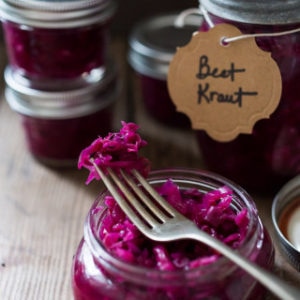Description
A simple easy, small-batch recipe for Beet and Cabbage Sauerkraut that anyone can make using a mason jars. Full of good healthy bacteria! Allow 5 days fermenting time!
Ingredients
- 1 small red cabbage- finely sliced (save a couple whole leaves , for the top)
- 1 cup grated raw beet- do not peel.
- 1/8-1/4 cup sliced red onion - optional
- mineral salt or sea salt (you will calculate)
- 1 teaspoon caraway seeds
- 1 garlic clove, sliced
- 1-2 teaspoons grated ginger
Instructions
- Place a medium bowl on a scale and zero out the scale, leaving the bowl there.
- Finely slice and grate cabbage and beets and place in the bowl. Add garlic, onion and or ginger if using.
- Weigh the cabbage in grams- careful not to include the bowl weight. Multiply the cabbage amount by .02. This is the amount of salt in grams you will need ( see notes). Zero out the scale again, with the filled bowl, and add the calculated salt.
- Massage the with the salt, Let sit on the counter, mixing occasionally for 1 hour, until cabbage has wilted and released a little water.
- Place cabbage beet mixture and all the juices in a CLEAN mason jars and pack it down with a muddler, or the end of a wooden spoon, leaving 2-3 inches at the top. Place a couple of cabbage leaves over the kraut to help keep it submerged under the liquid along with a fermentation weight.
- If there is not enough liquid to cover, mix one teaspoon sea salt with 1 cup of filtered water, and add just enough of this brine so cabbage-beet mixture is submerged- leaving at least 2-inches space at the top of jar. If any seeds or particles float to the top, remove them with a slotted spoon. Anything that is not completely submerged can mold. Cover loosely with a lid and place on a pan ( to catch any liquid).
- Place in a cool dark place ( ideally 65 -72 degrees F ) for 3-5 days. It may take longer to ferment if it is colder. I often place mine in the cooler part of my kitchen, covered with a big dishcloth. You can check it daily to make sure the cabbage is under the brine.
- After 3-4 days, check for activity. When you tap the jar, tiny bubbles should rise to the top, indicating it’s fermenting. Once fermented to the desired amount, add the caraway seeds and place it in the fridge. The longer it ferments the sourer it will taste.
- Once it’s chilled the smell will surprisingly mellow out and it will actually seem edible! So let it chill overnight, discard the cabbage leaf, then give it a taste!
Notes
Salt Ratio: The recommended salinity for Sauerkraut is 1.5% – to 2.5% salt to the weight of the cabbage. Here we use 2% salt to the weight of the cabbage. Example: 1ooo grams cabbage multiplied x .02= 2o grams of salt. Feel free to use more or less as long as it stays between 1.5% and 2.5%. I use Himalayan Sea Salt and Real Salt. Both are natural and unrefined with high mineral content.
Cabbage: Use organic cabbage if possible. Do not use pre-shredded cabbage. You need the natural bacteria from a whole cabbage. Farmers’ market cabbage works especially well.
Use a fermentation weight to keep the kraut submerged or something small and clean that will fit inside the jar, like a small shotglass.
Nutrition
- Serving Size: 1/4 cup
- Calories: 45
- Sugar: 3.4 g
- Sodium: 670.6 mg
- Fat: 0.2 g
- Saturated Fat: 0 g
- Carbohydrates: 10.2 g
- Fiber: 2.1 g
- Protein: 2 g
- Cholesterol: 0 mg
